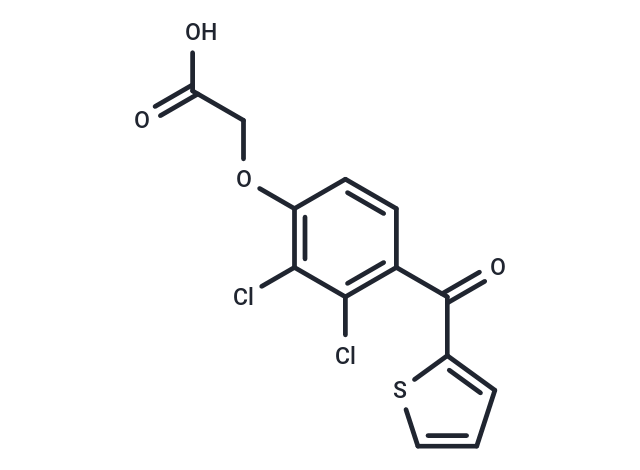Shopping Cart
- Remove All
 Your shopping cart is currently empty
Your shopping cart is currently empty

Tienilic Acid is a uricosuric diuretic with certain hepatotoxicity

| Pack Size | Price | Availability | Quantity |
|---|---|---|---|
| 5 mg | $39 | In Stock | |
| 10 mg | $72 | In Stock | |
| 25 mg | $147 | In Stock | |
| 50 mg | $218 | In Stock | |
| 100 mg | $323 | In Stock | |
| 200 mg | $483 | In Stock | |
| 500 mg | $776 | In Stock | |
| 1 mL x 10 mM (in DMSO) | $50 | In Stock |
| Description | Tienilic Acid is a uricosuric diuretic with certain hepatotoxicity |
| In vivo | In female and male Sprague-Dawley rats, Tienilic Acid decreased blood pressure and serum uric acid at 30 mg/kg. Tienilic acid decreased slightly hemoglobin and increased S-GPT at 120 and 480 mg/kg. Tienilic Acid significantly increase the liver weight and serum magnesium concentration in male rats, while the liver weight of female rats increased only slightly. Tienilic Acid also induced unicellular necrosis of small groups of liver cells[2]. |
| Molecular Weight | 331.17 |
| Formula | C13H8Cl2O4S |
| Cas No. | 40180-04-9 |
| Smiles | C(=O)(C1=C(Cl)C(Cl)=C(OCC(O)=O)C=C1)C2=CC=CS2 |
| Relative Density. | 1.532g/cm3 |
| Storage | Powder: -20°C for 3 years | In solvent: -80°C for 1 year | Shipping with blue ice. | |||||||||||||||||||||||||||||||||||
| Solubility Information | Acetone-d6: 250 mg/mL (754.90 mM), Sonication and heating to 80℃ are recommended. DMSO: ≥ 33.1 mg/mL, Sonication is recommended. | |||||||||||||||||||||||||||||||||||
Solution Preparation Table | ||||||||||||||||||||||||||||||||||||
Acetone-d6
| ||||||||||||||||||||||||||||||||||||

Copyright © 2015-2025 TargetMol Chemicals Inc. All Rights Reserved.